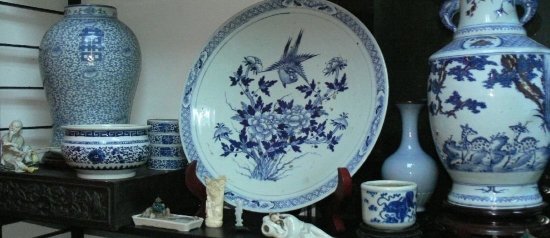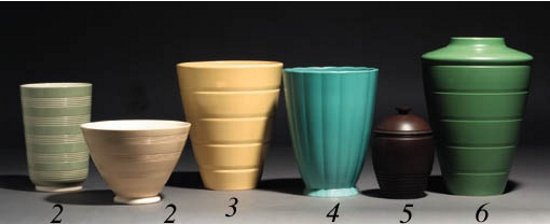Never in the history of English art and fashion have ceramics been as important as they were to the Aesthetic Movement.
Aestheticism was the most prominent movement in the fine and applied arts of the late nineteenth century and one of its great events was the exhibition of Sir Herbert Thompson’s collection of blue and white china. It was curated by Murray Marks, whose Oxford Street emporium was the epicentre of the blue and white cult. Marks was no mere shopkeeper; he was a close friend of the philosopher Schopenhauer and a benefactor of the major London museums. The exhibition previewed on 30 April 1878 at the fashionable hour of 11 pm. Those who attended included the ‘chief artists, dramatists, and actors, and & many notable people in London society’.1 There was a sumptuous catalogue, illustrating 50 pieces on 26 plates, twenty of which were painted by James Abbott McNeill Whistler.
Origins of the Aesthetic Movement:
Marks’ circle encompassed the great artistic figures of his day. In addition to Whistler, it included luminaries such as Ruskin, Swinburne and Rossetti. Indeed, Marks knew all the figures whose contributions were seminal to the development of the Aesthetic Movement. While its origins lay with the Pre-Raphaelites, it is Whistler who is seen as the quintessential Aesthetic artist. He self-consciously adopted Japanese effects. His best pieces benefit from abstracted backgrounds and a more open, asymmetric Japanese spatial sense. There is a certain silliness, however, about the way his European sitters are adorned with Japanese costumes, fans and screens.
A prominent theoretician of Aestheticism was the poet-aesthetician Swinburne. Of Albert Moore, a contemporary of Whistler, he wrote:
His painting is to artists what the verse of Theophile Gautier is to the poets, the faultless and secure expression of an exclusive worship of things formally beautiful.2
In other words, it was ‘art for art’s sake’. Gautier had asserted that nothing is really beautiful unless it is useless3 and, on this view, the notion art should contain moral precepts was an anathema.4
Japonisme:
The influence of Japanese prints was important in the case of Whistler and crucial in the development of Aestheticism generally. The impulse that gave particular prominence to Japan in the second half of the nineteenth century was the treaty with the United States signed by the Shogun in 1854. This diplomatic rapprochement soon led to a blossoming trade.
An interesting figure, strongly associated with the cult of Japan, was the Adelaide-born artist Mortimer Menpes. He joined the studio of Whistler in 1881 and ultimately was his biographer. He visited Japan in 1887 and returned with over a hundred paintings and numerous prints created during his stay. The exhibition of his paintings led Oscar Wilde to assert that Menpes had missed the point. It was not the reality of Japan that was important to art but Japan as an idea. If you really want to experience the Japanese, Wilde suggests, you simply stay at home and steep yourself in the works of certain Japanese artists. Then you go for a stroll down Piccadilly and ‘if you cannot see an absolutely Japanese effect there, you will not see it anywhere.’5
Beyond high art:
In the development of painting, Aestheticism was a cul-de-sac. Whistler was on intimate terms with the Impressionists, but his tortured and insecure personality prevented him embracing a radically innovative path. The Aesthetic Movement is important because of the width of its influence. For its more extreme adherents, it was a way of life. For many, and over quite an extended period, it was a fashion. For others it was nothing but a rather silly fad. But, one way or another, it had many people aspiring to partake of an aesthetic that saw in the attainment of beauty an absolute good.
At the heart of Aestheticism was a passion for china. Those who could afford it collected Oriental blue and white porcelains. Whistler had a collection; so did the poet and painter, Dante Gabriel Rossetti; so did Oscar Wilde. This passion became so emblematic that it was one of the favoured themes for satire. A cartoon, published by Du Maurier in Punch in October 1880, is titled ‘The six mark teapot’. It shows the ‘Aesthetic bridegroom’ and his ‘intense bride’ reverently examining the pot they have been given. He is saying: ‘It is quite consummate, is it not?’ and she replies ‘It is, indeed. Oh! Algernon, let us live up to it.’
Royal Worcester responded, the next year, by producing shape number 870, the famous Aesthetic teapot. It is modelled as a wan Aesthetic figure in a ‘stained-glass attitude’6 with one arm forming the handle and the other the spout. From one side it is the Aesthetic young man and, from the other, the Aesthetic young woman. The base carries the inscription ‘Fearful consequences through the laws of Natural Selection and Evolution of living up to one’s teapot.’
However, the Aesthetic Movement was far more than Japanese influence and imported Kangxi blue and white porcelain. In decorative arts terms, the movement came to embrace a whole range of sources and influences that produced things which could be seen to be exotic and intrinsically beautiful. Once the British factories sensed the beginning of a fashion trend they flooded the market with Aesthetic wares. Much was pedestrian and some simply banal. The best were among the finest and most innovative ceramics to emerge in Victorian times.
Notes
1 G.C. Williamson (Dr), Murray Marks and His Friends, John Lane, Bodley Head, London, 1919, p. 38.
2 Quoted in Robin Spencer, The Aesthetic Movement, Studio Vista, London, 1972, pp 35-37.
3 Preface to his novel Mademoiselle de Maupin, published in 1835 and quoted in Lionel Lambourne The Aesthetic Movement, Phaidon Press, London, 1996, p 10.
4 Swinburne wrote in his 1866 essay on William Blake that art ‘can never be the handmaiden of religion, exponent of duty, servant of fact (or) pioneer of morality’. Quoted in Lambourne, op cit, p 11.
5 Oscar Wilde, The Decay of Lying January 1889, quoted in Lambourne, op cit, pp. 45-46.
6 Bunthorne in Gilbert and Sullivan’s Patience speaks of the Aesthetes ‘uttering platitudes in stained-glass attitudes’.





